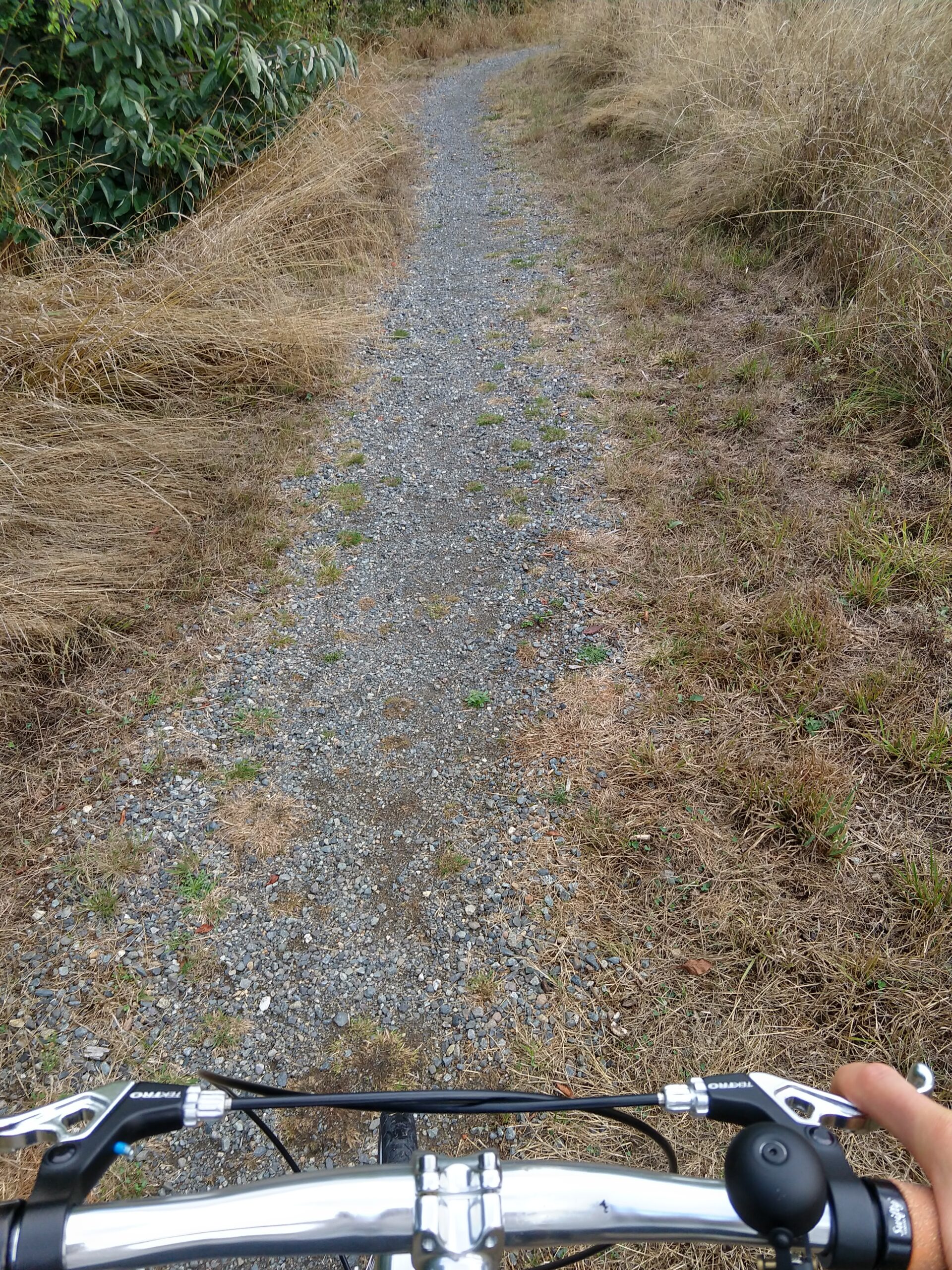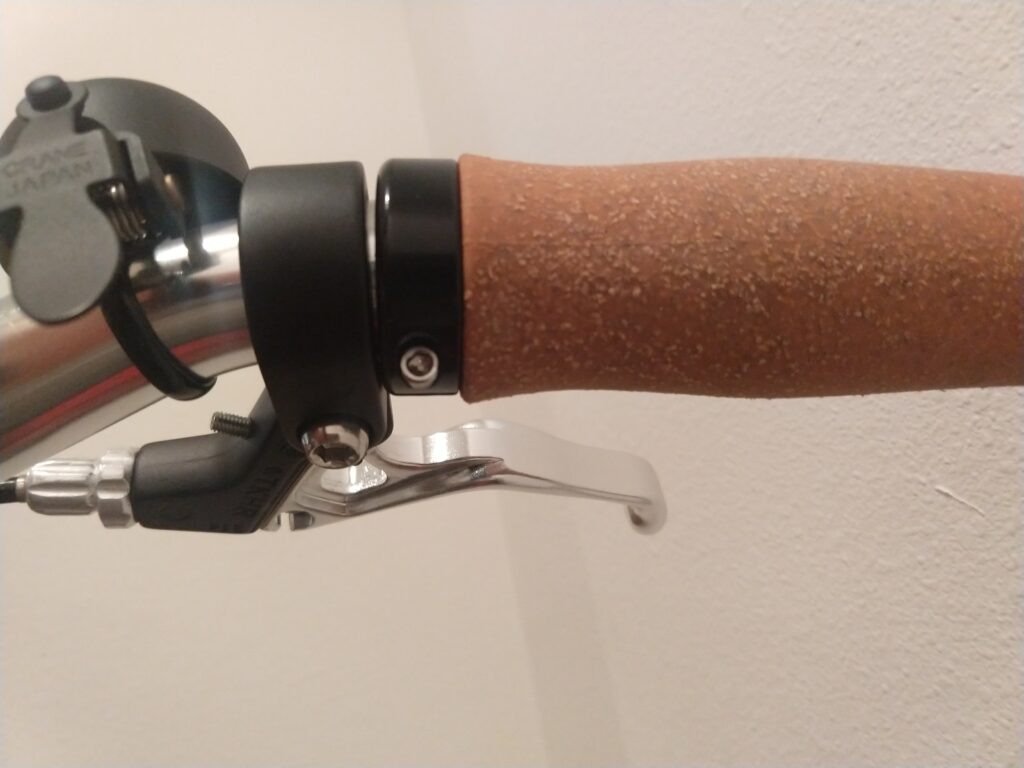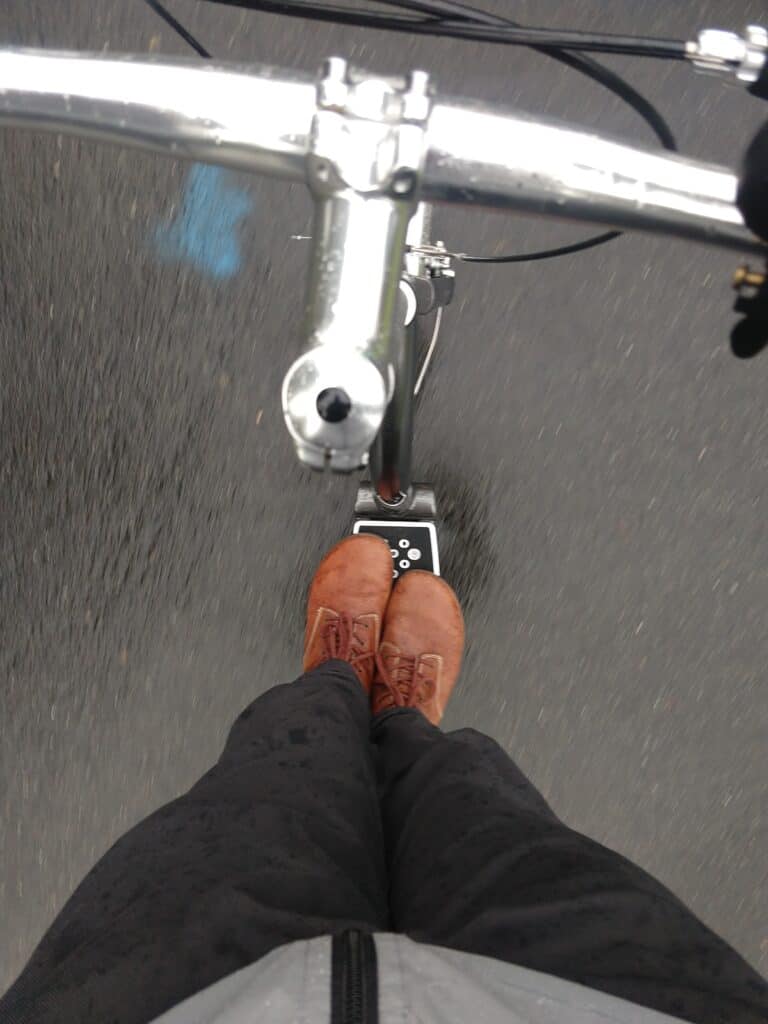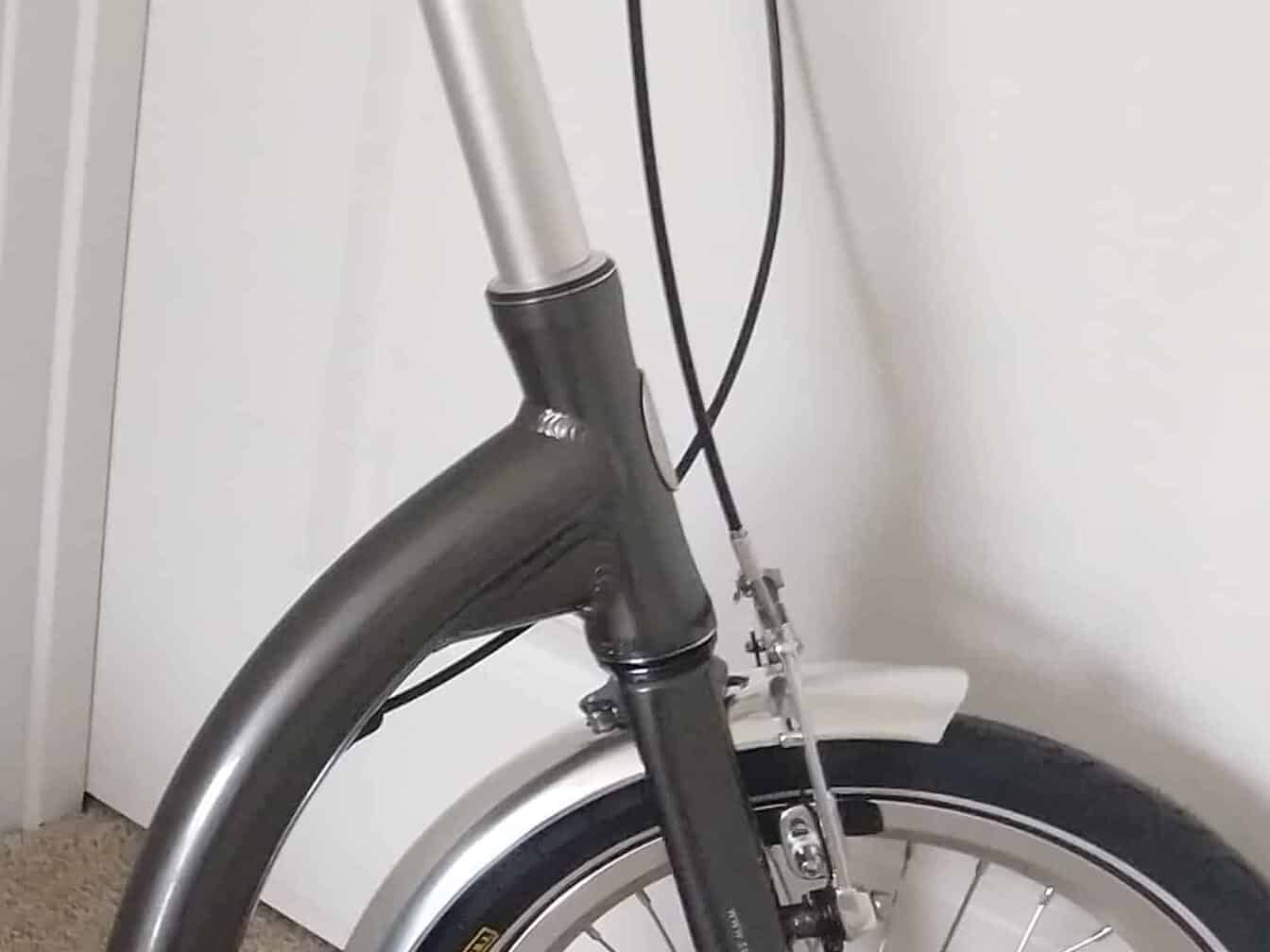Last updated: August 15th, 2023
Unlike their kid-sized siblings, adult kick scooters are amazingly useful around town.
Not to mention they’re just plain fun. You’ve got the convenience of walking plus a bit of the swooping-and-gliding sensation of cruising on a bike.
Well…that’s true for a while. Things change for the worse when you encounter gravel or potholes or bumps or sidewalk cracks or downhill stretches.
And in most towns, that’s inevitable.
So, you find yourself monitoring pavement quality with almost paranoid attention. That level of vigilance gets old before long.
Then, throw some wet leaves or debris in the mix, and all bets are off.
That all got me looking for a more sure-footed kick scooter that would be useful throughout the year, and maybe even look more grown-up.
The answer was a Swifty Zero.
After racking up quite a few miles, it lives up to my high expectations. It leaves almost nothing to be desired, as expected at this price.
Even so, it may not be the right choice for you, and we’ll take a close look at why that is.
But first, let’s cover a little background.
This article might contain affiliate links. As a member of programs including Amazon Associates, I earn from qualifying purchases.
What would you want in the perfect scooter?
Swifty is based near Manchester, England. They began in 2010 with a simple task: how to make a scooter that is fast and fun around the city, but as safe as possible, and actually useful year-round.
Bicycle design held the answer.
Think about what makes you comfortable and stable on a bicycle. It’s things like larger wheels, inflatable tires, wide handlebars, good brakes, a relaxed headtube (steering) angle, and a long wheelbase. Those were practically impossible to find on scooters.
A few obscure European “foot-bikes” had been available for ages, but most are too large (and, frankly, funny-looking) for practical use.
So Swifty founders Jason and Camilla Iftakhar (a husband-and-wife pair of trained designers) built their own scooter from the ground up. They picked useful, time-tested bits of bike design and shaped them into a kick-powered package.
The first model, quite appropriately named the One, is a folding option. Think of it as the Brompton of scooters.
There’s also the Zero, which I’m reviewing here. It loses the fold and the handlebar height adjustment, but has slightly better braking and costs a fair bit less than the One. The size and geometry aren’t identical to the One, but they’re extremely close. I wouldn’t expect a noticeable difference.
Finally, the Air is for more aggressive riding. It doesn’t fold (for the sake of strength) and it ships with fatter tires and an all-around stronger frame. Its geometry is slightly different, too.
Swifty unboxing & assembly
I’ve sent and received upwards of a dozen bicycles via couriers. None of them was as perfectly packed as the Swifty.

Empty spaces in a cardboard box are easily crushed. To prevent this, the factory filled them with large, dense foam pieces.
Start to finish, I spent less than 20 minutes assembling my Zero. That includes unpacking time. Actual, hands-on assembly was probably under 15 minutes.
(I’m a capable but decidedly amateur bike mechanic. This was all familiar territory, so it may take you longer.)
The Swifty fenders (or “mudguards” outside North America) were a bit more complicated. There are quite a few small screws, nuts, and washers to keep track over, so it’s worth slowing down and following the instructions to the letter.
But it was well worth it, and not remotely difficult aside from keeping track of the hardware.
The fenders fit beautifully, and were clearly customized for the specific model. No two bike (or scooter) models have exactly the same fender mounts and positions, so generic fenders can be awfully frustrating to install. I’ve often resorted to hacksaws and exotic hardware. You may find cheaper fenders elsewhere, but I happily paid the premium for Swifty’s own, properly-fitting model.
I was able to install both the front and rear fenders without removing either wheel. Just deflate the tire so it’s easily compressed, and use a ball-end hex key if you have one. It’s slightly slower, but I prefer it to reinstalling wheels with bolt-on axles.
What I love about the Swifty Zero
This could be a long section, since there’s a lot to like. I’ll try to stick to factors that aren’t obvious in their web pages or YouTube videos.
It really boils down to two things: a great ride and great design. That’s all a little nebulous, perhaps, so below is what I mean.
Rough streets (or paths) are never a problem
Large wheels have obvious benefits on rough ground, and the Swifty lives up to expectations.
To be clear, the One and Zero are made for general riding. If you’re contemplating off-road, freestyle, or otherwise slightly crazy pursuits, then buy the burlier Air instead.
But for cruising around town, with choppy asphalt here and there, and a little packed dirt or gravel along the way, the Zero (and One) is just the ticket.

All this makes for a relaxing ride.
For me, that’s a big deal. And it might be for you, too, depending on what you have in mind.
For scooting a couple blocks to the corner store or bus stop, it’s probably overkill.
But for recreation or local errands, then the last thing you want is the stress of a twitchy, unstable design that threatens to throw you off at every pebble or pothole. It’s just too unnerving to ride like you intended.
Obviously, 16″ wheels do a lot to smooth things out. At twice the diameter of your standard 8″-wheeled kick scooter, they can roll over something roughly twice as tall without incident. (Actually, probably a little more than that, since pneumatic tires compress and absorb a little impact.)
But that’s not the whole story. You could all too easily design a scooter with large wheels only to find it’s still twitchy and unnerving. That’s why frame geometry makes a huge difference, as well. Cyclists tend to pore over geometry charts precisely because they tell you all sorts of things about how the model at hand will actually ride.
All else being equal, a longer wheelbase will feel steadier over bumps. On normal terrain, every two-wheeled vehicle handles best when you’re centered between the two wheels. The longer the wheelbase, the easier it is to stay there, and Swifty uses long wheelbases indeed.
Another important feature is something called the head tube angle. That’s basically the angle between the ground and an imaginary line from the front axle to the handlebars.
As it gets slacker (less vertical), it’s harder for bumps to jar your handling or throw you off-track.
Going from a Razor to a Swifty feels like going from a Mazda Miata to a Cadillac Escalade. In bicycle terms, it’s like going from a track bike to an enduro bike.
The main reason—aside from wheel size—is the Swifty’s longer wheelbase and slacker head tube angle.
For reference, here’s a comparison between the Swifty Zero (top) and a Ninebot electric scooter (bottom). That Ninebot is already a longer and slacker design than almost any 8″-wheeled kick scooter, so the difference between a Swifty and something like a Razor is even more than pictured.

It doesn’t matter much when you’re crawling along the sidewalk at walking speed. In fact, the short but twitchy design might be preferable if that’s primarily how you use it.
But at higher speeds, unsteadiness tends to lead to bad things…like crashing. So if you want a fun and safe ride without continual and paranoid attention to the ground, then something like the Swifty Zero is what you’re after.
Small, thoughtful touches that others neglect
When you pay a premium price, you expect thoughtfulness from start to finish. You might even call it an “experience,” just like unboxing an Apple product versus a generic alternative. You’re offering top dollar partly in exchange for having nothing to worry about.
Swifty overlooked no details, and this is where the founders’ design background shows through.
For instance, I’ve never seen anybody else offer cork-blend lock-on grips on a kick scooter. They’re functionally and aesthetically terrific, which you’ll immediately understand when you hold one in hand. As a matter of fact, I’ve spent a pretty penny installing them on my city bicycles.

The internal cable routing for the rear brake is another small but lovely touch. Few things are uglier than a brake cable zip-tied all around the clean line of the frame.
Bicycles often use internal routing for tidiness, but I’ve never seen it on a scooter before. (This only applies to the Zero and Air. The One has a foot brake, so there is no rear brake cable in the first place.)
Other little details, like the quality of grip tape or choice of brand-name brakes, are also nice. I won’t belabor these since they’re evident at a glance.
But I will belabor this: all the details add up to the classiest kick scooter on the market.
Whether you find scooters classy in general is another matter, but it’s safe to say that none is more refined or well-spec’d.
No corners are cut, period.
I expected no less at this price, and the build quality meets my high expectations.
Why a Swifty might not suit you
I’ve spent a while trying to find something truly wrong with the Swifty Zero…
Thus far, I haven’t.
But being good on paper, and a good choice for me, doesn’t make it perfect for you.
In that spirit, here are a few things to bear in mind.
Are they deal-breakers, or just caveats? That’s up to you.
It’s just plain expensive
There is no getting around the fact the Swifty scooters are expensive.
The Zero is the cheapest, at US $578 as of writing, and the Air and One cost a bit more.
Mind you, that’s before fenders ($50) and shipping to the US ($60, if memory serves). You’re putting down a pretty significant amount of money.
If you’ve bought a bicycle, then you’re probably used to getting a full drivetrain, disc brakes, and maybe even suspension for about the same price. Most of those things wouldn’t make sense on a scooter in the first place, but the point is that a Swifty includes less “stuff” for your money than a similarly-priced bicycle.
In short, if money is tight and you need transportation first and foremost, then you’ll get more value from a bicycle, especially secondhand.
All that said, keep in mind that Swifty is a small brand with a basically one-of-a-kind product. So far, it’s simply too niche to produce at the scale that really drives prices down.
There’s no getting around the fact that bikes can deliver more bang for your buck, on average. But at the end of the day, you’re still getting a high-quality product with lots of thoughtful touches.
And being the only model of its type does make it the cheapest, in some sense…
Even the foldable one isn’t tiny
As best I can tell, all these ride quality and build quality details apply to all Swifty models, not just the Zero reviewed here.
That’s a good thing, because if space is at a premium, you’ll definitely need to get the foldable Swifty One.
But if you’re really tight on space—we’re talking crowded public transit or Hong Kong apartments—then even the One may still be a little too large.
At about 42″ L x 26″ H x 6.3″ W, it’s going to fill up the leg room in front of a couple of bus seats. Its front section doesn’t have a horizontal fold, which is how a Brompton bicycle folds down to its impressive 23″ x 22″ x 11″. (Having owned a Brompton, even those can be slightly tough to fit on city buses.)
If you need that sort of compactness, then you’re better off with a Razor A5/A6, Xootr, Micro, or any of the several other more typical kick scooters. None rides remotely like a Swifty, but all are lighter and smaller.
The Swifty One is the threshold below which you have to trade ride quality for portability. And the Zero, of course, is akin to the One but permanently unfolded.
The deck is on the higher side
If you try a few different kick scooters, you’ll notice that some feel easier or harder than others to ride.
Unless you have a flat tire or something obviously wrong, the difference isn’t actually the wheels. It’s more likely the deck height.
Higher decks feel more tiring, all else being equal. More specifically, it’s your standing leg that gets tired quickly.
First-time riders find this surprising; you probably wouldn’t expect that leg to fatigue. But consider that it has to support most of your weight while kicking. The higher the deck, the deeper your standing leg needs to bend (like a one-legged squat), and that’s more work to sustain.
The Swifty’s deck is a bit higher than most, for two reasons.
First, the large wheels are so capable that you’ll inevitably ride over curbs and speed bumps and so forth. You’re paying good money not to ride a dinky kid’s scooter, so no sense holding back as if you were on one!
But to roll over those things safely, it needs significant ground clearance. That, of course, requires significant deck height.

Second, the deck needs to be strong enough for years of use by bigger riders (up to the 330-lb weight limit). Wider frame tubing means more strength. When you put the sturdy, wide tubing on top of generous ground clearance, you’re standing about 4.5″ off the ground.
On good surfaces where ground clearance isn’t a problem, that makes for a more tiring ride. It’s not a world of difference, but it will take a while for your legs to strengthen and adapt. Taller riders and/or those with larger feet will notice less of a difference, too.
But here’s the good part. On poorer surfaces, the generous ground clearance and large wheels roll far better. That means more coasting, less kicking, and less tired legs on rougher stretches. You don’t need to worry too much about scraping the bottom on sidewalk cracks and whatnot.
All this is a roundabout way of making a simple point. The higher deck is more tiring than you might be used to. Ease into it, especially if you’re not yet as fit as you’d like to be. But the ease of riding on imperfect ground makes this a good trade, in my book.
Speaking of the deck, its length is ample for anybody but its width is slightly narrow. Nowhere near the cramped feel of a Razor, but it’s hard to fit two shoes side-by-side.
Below is an example of how they (don’t quite) fit side-by-side.

To coast with both feet on the deck, you’ll need to angle them a bit. Even then, at least one will hang off slightly.
However, that’s not an entirely bad thing.
Firstly, it’s easy to get the feel of positioning your feet after your first couple rides. With a little practice, your feet don’t have to grope so much for the right spot. They just start to land there intuitively, even as you switch kicking feet.
Secondly, if the deck were significantly wider, it would be too easy to catch your ankle when kicking vigorously. And that, I can attest, is a pain you’d rather avoid.
Bicycle-style parts mean bicycle-style maintenance
The wheels and brakes on your run-of-the-mill adult kick scooter really aren’t good.
But what they are…is low-maintenance.
And by exchanging them for bicycle-style parts, the Swifty gains capability and safety at the cost of maintenance.
We’re not talking about anything complex–and certainly less than a bicycle, what with its drivetrain. Still, here a couple things that may or may not dissuade you.
Brakes
The Swifty’s v-brakes have been a standard bicycle part for at least a couple decades now. They’re a time-tested design that works beautifully and simply.
However, you’ll need to attend to them in two ways.
Upon delivery, you need to get the cable tension right. Mine was actually perfect out of the box, but I don’t know whether that’s by design (one hopes!) or by coincidence.
And over time, all cables stretch. This is as simply as backing the barrel adjuster out whenever a brake feels too soft.
You’ll eventually need to replace the brake pads, too. Given the low mileage most scooters see, that won’t be any time soon.
Tires
As with a bicycle, you’ll need to get in the habit of checking tire pressure at least weekly. Realistically, the inner tubes should hold air for longer than that, but it’s better safe than sorry.
Any bicycle bump with a Schrader adapter will work fine.
There is always the chance of a flat tire, too. That’s always a nuisance, especially when you’ve got to change it in bad weather to get home. As a preventive measure, fill the inner tubes with Slime Tube Sealant (Amazon link). As a bonus, the sealant should also minimize air leakage over time.
Incidentally, all bicycle-style wheels need to be “trued” on occasion. That’s the process of tightening spokes to keep the rims symmetrical and aligned. If you notice the brake pad rubbing the wheel during part of every revolution, that’s a sure sign that it needs truing.
It’s a standard part of a bike tune-up. Many cyclists (including me) do it themselves at home, and any shop can take care of it for you.
Headset
Finally, keep an eye on the headset, which is the rings of bearings where the steerer enters the frame.

Watch that it doesn’t develop some play or looseness, and listen for a crunchy sound that could indicate bearing problems.
If you set it up properly, then it should work without issue for years, and perhaps decades. But if it was over- or under-tightened, or if your weather is really harsh, then a fresh headset might be necessary at some point.
If need be, any bike shop can help with all the above, and probably at a reasonable price. Compared to the complexity of bicycle suspension or even just hydraulic disc brakes, working on a Swifty is child’s play!
I do want to emphasize that the maintenance burden is minimal. Giving tires and brakes a couple minutes of attention every few weeks, or what have you, isn’t too much of a drag. It’s more of a caveat for those who’d plan to store the scooter for months on end, pop out for a quick ride, then put it away again for the season.
Most infrequent riders would balk at the price of a Swifty in the first place, at understandably so. But if you want something almost totally hands-off for very sporadic rides, then you might be happier with a more conventional scooter.
Bottom line: worth it, but not for everyone
I could continue raving about the Swifty’s ride quality all day. Compared to anything else readily available, it really is that much better.
And the overall package is unquestionably thoughtful and well-executed.
But that price tag…is significant.
If you’re lukewarm on the whole idea of adult kick scooters, and don’t know that you’ll ride more than a few miles in good weather, that’s just fine! But if money is a consideration, then spend less of it on a more standard option.
Same goes for those with really, really tight space requirements. Even the folding model won’t quite tuck away out of sight.
But if you actually will put in serious miles…
And you actually will ride it in wet weather or on rough roads…
Then you’ll get your money’s worth. Swifty makes the right tool for that job, plain and simple.
FYI, they seem to sell out quickly. I believe my own Zero was the second-to-last one available for several months. I hope you won’t end up having to wait that long, but check inventory here to find out.
